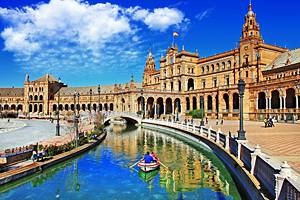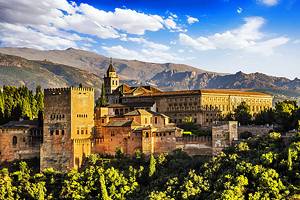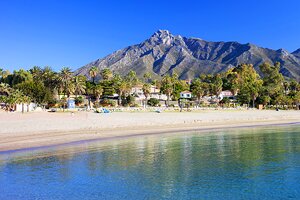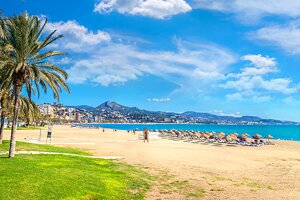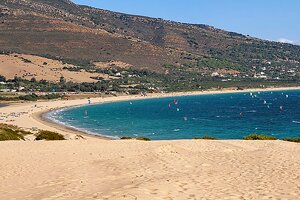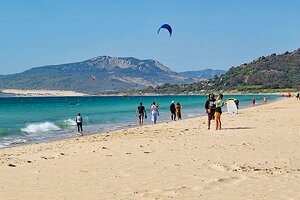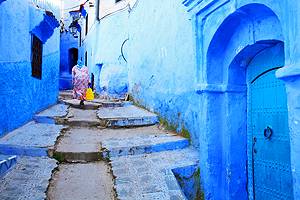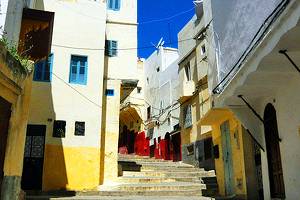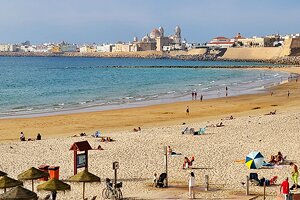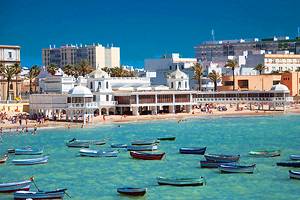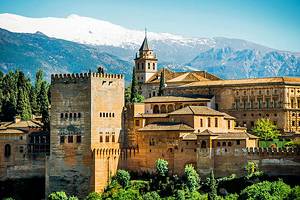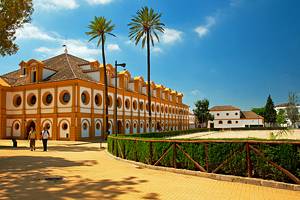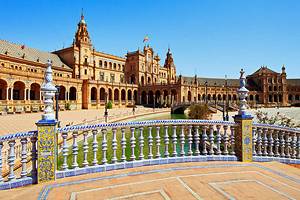Attractions & Things to Do in Marbella
Author Michael Law spent 10 weeks in southern Spain visiting destinations along the Costa del Sol.
This fashionable town nestles along an idyllic portion of the Costa del Sol, with the Sierra Blanca mountain range as a backdrop. Palm-trimmed promenades draw locals and tourists for leisurely strolls, while beach clubs and golf courses cater to an upscale clientele.

The beaches and the quaint historic center, the Old Town (Casco Antiguo), are the main attractions. But, if you are looking for things to do in Marbella off the beach, explore the squares, historic landmarks, art museums, and boutiques.
Historic Marbella is an enchanting old Moorish town full of whitewashed houses, cobblestone streets, and shady trees. Many of the old buildings are adorned with ironwork balconies and dripping with vibrant bougainvillea.
Discover the best places to visit in this seaside resort with our list of the top attractions and things to do in Marbella.
- Plaza de los Naranjos
- Paseo de La Alameda: An Elegant 18th-Century Park
- Spend a Day at the Beach
- Puerto Banús and its Waterfront Restaurants
- Avenida del Mar and the Dalí Statues
- Iglesia de Nuestra Señora de la Encarnación
- Murallas del Castillo: Ruins of a Moorish Castle
- Museo Ralli
- Museo del Grabado Español Contemporáneo
- Mezquita del Rey Abdul Aziz al Saud (Marbella Mosque)
- Iglesia del Santo Cristo de la Veracruz
- Capilla de San Juan de Dios
- Plaza Altamirano
- Map of Attractions & Things to Do in Marbella
Plaza de los Naranjos

In Marbella's charming Old Town (Casco Antiguo), the Plaza de los Naranjos is the place where locals and tourists come to socialize and relax. A number of attractions line the square, and several restaurants with outdoor patio seating are set beneath leafy trees.
This beautiful town square has become the heart of Marbella. The Plaza de los Naranjos blossoms with fragrant orange trees in springtime. The group of orange trees is planted right in the middle of the square, providing welcome shade during the summertime.
Two important historic landmarks found here are the town hall (Casa Consistorial, built in 1572), and the oldest parish church in Marbella, the 16th-century Ermita de Santiago (Santiago Hermitage). This simple whitewashed church possesses a noteworthy contemporary sculpture of Saint James the Apostle.
A nearby attraction for gourmands is the Restaurante Skina, which holds two Michelin stars. This gastronomic destination is a few blocks away (a five-minute walk) from Plaza de los Naranjos at 12 Calle Aduar.
Paseo de La Alameda: An Elegant 18th-Century Park

Filled with leafy palms and shady pine trees, the Paseo de La Alameda is a peaceful public park in the Old Town that joins the Paseo Marítimo along the seafront. It's a delight to wander through here after spending time in the Old City's warren of narrow streets.
The park features a main promenade with marble walkways; decorative benches shaded beneath banana palms; and fountains, like the Fuente Virgen del Rocio, which was made in 1762.

The park is also home to botanical gardens, and it was the city's first designated green space.
A small kiosk located in the southern part of the park sells cold drinks, snacks, newspapers, and magazines.
Address: Av. Ramón y Cajal, s/n, 29602 Marbella, Málaga, Spain
Spend a Day at the Beach

Marbella's name means "Beautiful Sea," and the town lives up to this moniker with fine sandy beaches. Several excellent choices are within a short walk of the historic center of Marbella. Most of the public beaches have restroom facilities and lifeguards on duty during summer.
Playa Casablanca should be number one on your beach list. Beautiful sand, a happening scene at the high-end chiringuitos, and a palm-treed walkway make the area a place to see and be seen. The beach is pleasantly busy but not overrun. If you want to stay here, check out the very high-end Marbella Club.
Coming in at a close second to Playa Casablanca is Playa Real de Zaragoza. This wonderful beach is a mix of natural areas and built-up spots. The beach is the perfect width for the formation of wonderful shallow tidal pools of warm water, a favorite for families with small children. The beach also has its fair share of moderately priced chiringuitos and chair rental places.

A favorite of those staying in the Old Town or in the heart of Marbella is Playa de Venus. Find it easily at the end of Avenida del Mar just past all the amazing Salvador Dali artwork. The beach is very busy with people enjoying the sun; sand; and shallow, calm waters. Wander up from your beach chair to one of the top-notch restaurants serving tapas and other more tourist-oriented fare.
Others to consider are Guadalmina beach, Linda Vista beach, and San Pedro Alcántara. These three are ideal for families. The sandy beaches are rated as "Blue Flag" because of their calm, safe waters, ideal for wading and swimming.
Read More: Beaches in Spain
Puerto Banús and its Waterfront Restaurants

About 10 kilometers from the Old Town, Puerto Banús is the fashionable marina in Marbella, where the jet-setting crowd comes to see and be seen. Stylish restaurants and upscale boutiques line the waterfront. Oddly, you'll also find vendors on the street selling cheap knockoffs.
The restaurants have outdoor terraces for the perfect seaside ambience. You can eat dinner while watching luxury yachts bob up and down in the harbor.
With hundreds of berths for yachts and other boats, Puerto Banús is considered one of the best yacht marinas in Spain. The marina also offers boat rentals, and many sailing trips and other tours leave from here.

Puerto Banús is an odd sort of place, filled with the haves and the looky-loos of the world. The luxury shops line the waterfront area, but only 50 meters away is a down-market area of cheap establishments and kebab stands.
Certain parts of the marina and shopping areas nearby were once owned by former crooked foreign government officials. Those officials had their assets seized by the Spanish government in 2017, and some of the buildings that tourists stop to gawk at are starting to show a distinct lack of maintenance. However, all that said, it's still a worthwhile place to visit, and the nearby beaches are some of the best in the area.
Address: Puerto José Banús, Muelle de Honor, Marbella
Avenida del Mar and the Dalí Statues

Art lovers will want to make time for a stroll down the Avenida del Mar, a lovely pedestrian way that stretches from the Paseo Maritimo to Parque Alameda. It serves as an outdoor showcase, with a permanent exhibition of Salvador Dalí's imaginative bronze statues, including 10 Dalí works, as well as two additional sculptures by artist Eduardo Soriano.
The pedestrian avenue is in an area where prominent residents once came to show off their decorated carriages. In the 1990s, the space was converted into a modern promenade but is still a popular place to visit for locals and visitors. A large parking lot is located beneath Avenida del Mar and is an excellent place to park when visiting the city center and beaches.
Iglesia de Nuestra Señora de la Encarnación

The Iglesia de Nuestra Señora de la Encarnación (Church of the Incarnation) is the most important church in Marbella's Old Town. Built in the 16th century by the Catholic Monarchs, the church stands on the site of the former Mosque of Marbella. It was common practice in 16th-century Andalusia to replace the mosques with new churches.
The building features a spacious basilica plan with a barrel-vaulted central nave and a semicircular apse with Corinthian columns. A distinguishing feature of the facade, the main door is exquisitely carved from ochre stone in Rococo style, an 18th-century enhancement. The sanctuary boasts a Sol Mayor Organ, considered the finest type of modern organ built in Spain.
The church is open to the public daily (free of charge) for cultural visits and prayer. Mass is celebrated here throughout the week, with two services daily Monday through Saturday, and several services on Sundays.
Address: Plaza de la Iglesia, Marbella, Spain
Murallas del Castillo: Ruins of a Moorish Castle

The Murallas del Castillo stands as the last remains of an old Moorish citadel (fortified castle and city). These immense crenelated walls with two towers are the only relic of Muslim civilization in Marbella. The walls date to the 10th and 11th centuries, the Moorish Caliphate period. They were restored in early 1735 and remain in good condition.
Although there is nothing to visit within the walls, it is definitely worth taking a look. The enormous proportions of the walls hint at the ancient citadel's grandeur.
Address: Calle Portada, Marbella, Spain
Museo Ralli

Between Puerto Banús and Marbella's Old Town, the Museo Ralli is a worthwhile excursion (about a 10-minute drive away). The Ralli Museum is housed in a completely renovated building with 10 spacious exhibition rooms.
This museum is part of the Ralli Museums, a group with other branches in Punta del Este, Uruguay; Santiago, Chile; and Caesarea near Haifa in Israel. The Ralli Museums boast one of the world's best collections of Latin American art.
At the Marbella Museo Ralli, visitors will discover an extensive collection of works by contemporary artists from a variety of Latin American countries. The paintings on display reflect the influence of the great European masters.
Address: Urb. Coral Beach, Marbella, Spain
Museo del Grabado Español Contemporáneo

This renowned art museum is another top attraction in Marbella's Old Town. The museum occupies the Bazán Hospital, an elegant Renaissance Gothic-Mudéjar building founded in the 16th century and registered as a protected historic monument. Admission is free.
The only museum of its kind in Spain, the Spanish Contemporary Engravings Museum is devoted to the preservation and exhibition of contemporary engravings and Spanish graphic artwork from the 20th and 21st centuries.
The museum has an extensive collection of more than 4,000 artworks. Artists represented in the permanent collection include Goya, Picasso, Miró, and Dalí.
Temporary exhibitions, organized in coordination with other major museums in Spain, are held frequently at the museum.
Address: C. Hospital Bazán, s/n, 29601 Marbella, Málaga, Spain
Mezquita del Rey Abdul Aziz al Saud (Marbella Mosque)

The Marbella Mosque was the first Mosque built since the Christian Reconquest of Spain in the 15th century. It was built by Prince Salman of Saudi Arabia in 1981, and is a splendid example of contemporary Andalusian architecture inspired by the Moorish heritage.
The mosque is surrounded by well-maintained Mediterranean gardens and contains a library collection of 30,000 volumes, which focus on Koranic studies. It is located just off the "Golden Mile," about 10 minutes west of Marbella's Old Town, about halfway to Puerto Banús.
Address: Las Lomas de Marbella, Marbella, Spain
Iglesia del Santo Cristo de la Veracruz

A historic church in the Old Town near the Murallas del Castillo, the Iglesia del Santo Cristo de la Veracruz was built in the 16th century as part of a Franciscan convent. The church facade features stone details and an octagonal glazed-ceramic tile roof. The interior is a humble space with a single nave and Andalusian-style décor.
The Iglesia del Santo Cristo de la Veracruz is a bit out of the way and not a hot spot on the tourist track in Marbella, so you'll likely have the place to yourself.
Address: Pl. Santo Cristo, 29601 Marbella, Málaga, Spain
Capilla de San Juan de Dios

Finding your way through the narrow and twisty streets of the Old Town to the Capilla de San Juan de Dios on Calle Caridad is half the fun of a visit here. This Mudéjar (Moorish Christian style) chapel was part of a hospital built by the Spanish Monarchs in the 16th century. This is a small and somewhat unassuming church, but the iconography within is impressive and moving.
Be sure to turn your attention upwards when you look in — the Capilla has an impressive Mudejar coffered ceiling.
Address: C. Misericordia, 2, 29601 Marbella, Málaga, Spain
Plaza Altamirano

Tucked away in a quiet corner of the Casco Antiguo, the Plaza Altamirano captures the historic ambience of the Old Town. This lovely cobblestone square is filled with leafy palm trees and old-fashioned streetlamps. The quaint old buildings feature classic ironwork balconies trimmed with bougainvillea.
Take advantage of the charming old-world ambience with some al fresco dining here, especially on balmy summer evenings.
An interesting tourist attraction on the square is the Archeological Collection housed in the Department of Culture's central office, a renovated 16th-century building. The collection includes archeological discoveries found in the Marbella city center and its surroundings such as at the Alcazaba, Roman Baths, Río Verde's Roman Villa, and the Vega del Mar Paleochristian Basilica.
Map of Attractions & Things to Do in Marbella
More Related Articles on PlanetWare.com
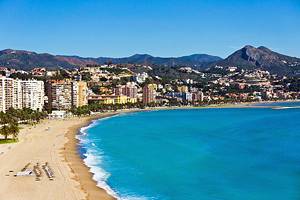
Málaga: Málaga is among the loveliest of the Costa del Sol vacation spots and is one of the best beach destinations in Spain. Málaga also has an atmospheric Old Town that is brimming with shops, cafés, and tapas restaurants. History lovers will want to see the Roman amphitheater, old Moorish Castle, and the 13th-century Alcazaba.
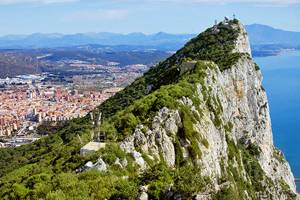
Little Britain: Connected to the mainland by a thin strip of land, tourists can literally step across the border from Spain to the tiny British territory of Gibraltar. In addition to authentic "fish & chips" and afternoon tea, there is stunning scenery and incredible wildlife at the nature reserve. The reserve has a cable car to provide the best views and is home to Europe's only wild monkeys, the Gibraltar apes.
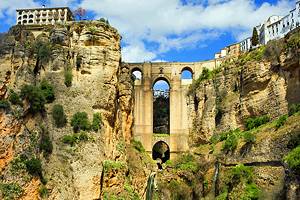
Highlights of Andalusia: Southern Spain's most alluring region, Andalusia beckons visitors with its fascinating heritage and incredible cultural attractions, such as the Alhambra. The quintessential Andalusian city of Seville is prized for its old-world charm and monumental Gothic cathedral, while Córdoba has a UNESCO-listed 8th-century mosque, and Ronda also boasts interesting historic sites, including a Moorish Old Town and the Baños Árabes (Moorish Baths).



